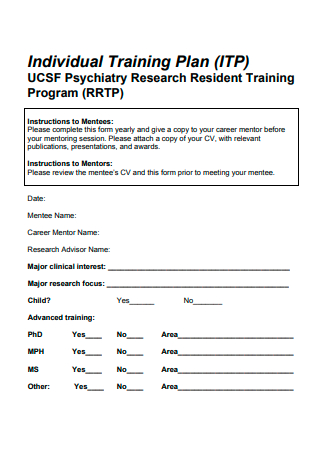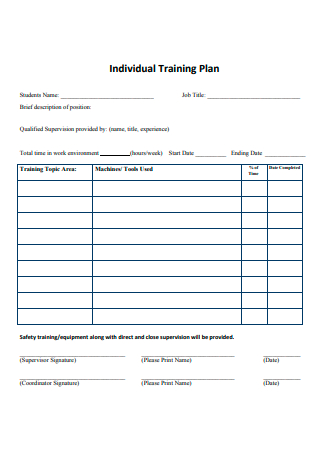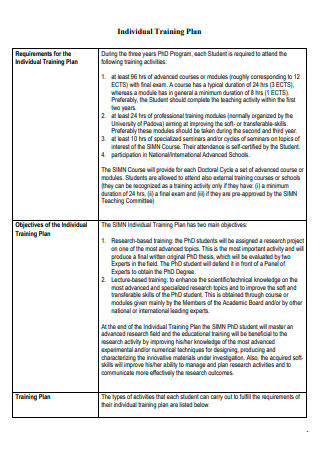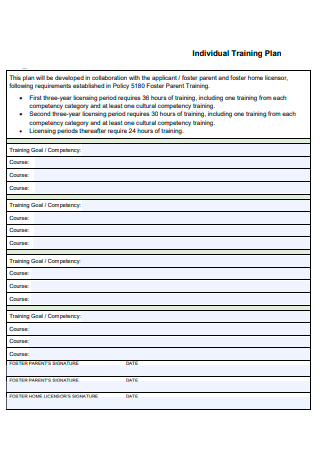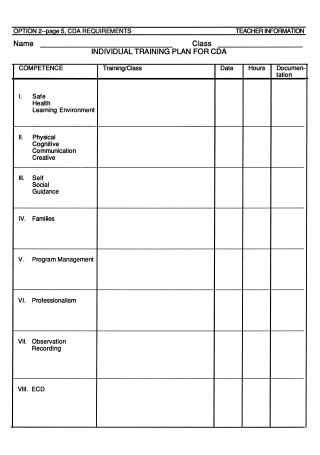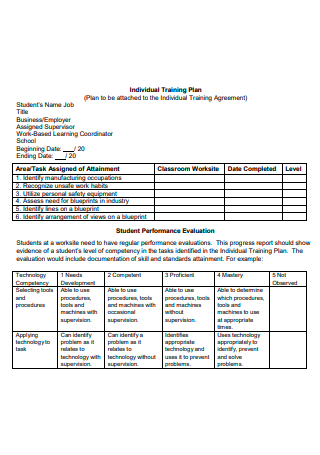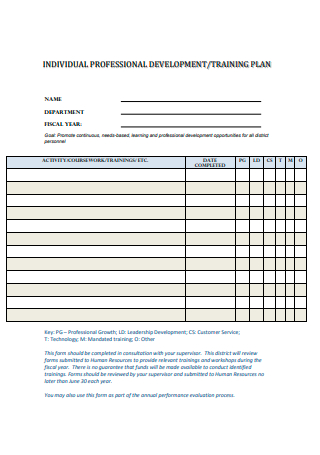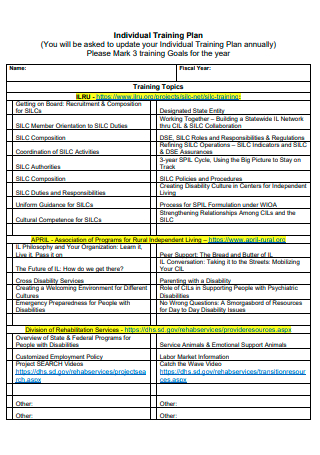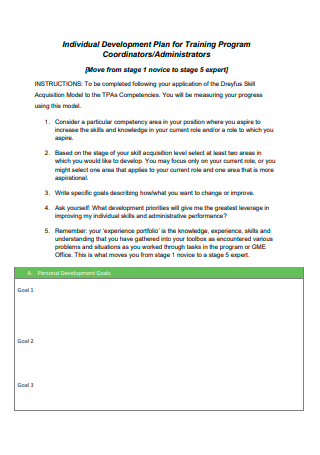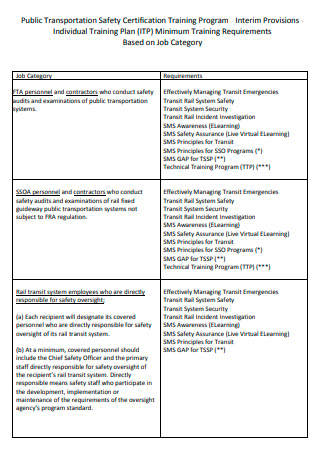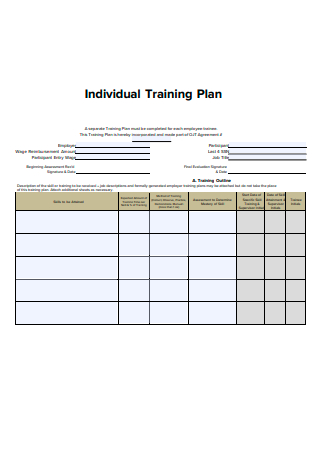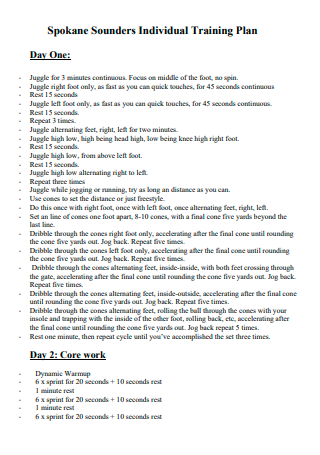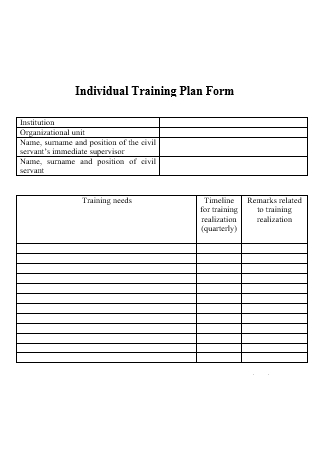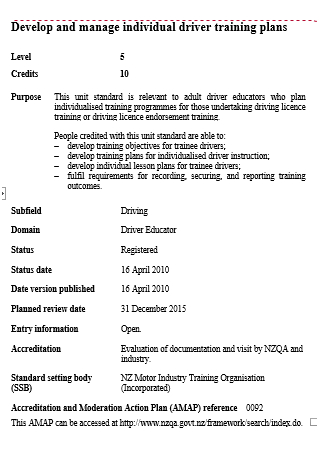18+ Sample Individual Training Plan
FREE Individual Training Plan s to Download
What Is an Individual Training Plan?
A printable individual training plan is a selection of programs that should be applied and assessed on a continuous basis to a single person. It might be a stand-alone training method, or a curriculum designed specifically for personnel. It contains specific aims that are desired to be produced in a certain individual. Individual training plans pdf might be physical, psychological, or mental in nature. Self-evaluations and self-assessment are part of the training strategy. Its purpose is to constantly monitor their growth and the effectiveness of the training on their development. A person can create their own personal training regimen on their own. However, it is preferable to talk with a professional or qualified person to develop an effective plan.
Different Kinds of Training Methods
The effectiveness of a training plan will be determined by the affinity that exists between the method and the individual. Individual training plans for students using oral approaches, for example, may not be beneficial for visual learners. As a result, while developing an individual learning or training plan, it is necessary to assess which method is more appropriate. This is not only to expedite development, but also to boost success. Let’s look at the many training methods available:
Lectures: Students are frequently the target audience for lectures. However, on-the-job training includes lectures. They, on the other hand, have more hands-on practice. A well-prepared presentation by a teacher or instructor is referred to as a lecture. It is an oral presentation or educational discussion about a certain topic or subject. Of course, the speaker must be knowledgeable about the subject matter. This type of training method is available without the need for prior information on the subject. Although it is advised, it is not required to read any educational texts about it. The engagement between the mentor and the student is the best part of lectures. It’s not a fast-paced nor technical. It is a carefully planned, slow-paced educational technique that enables for interaction between two parties. It’s also comprehensive and firmly focused on a single topic. Job Shadowing: Job shadowing is a sort of training in which an on-the-job employee observes another employee at work. They can then see up close and personal the task that they will be doing once they have completed their training. Job shadowing is a crucial part of job training, especially for new employees. Apart from lectures and practical instruction, their knowledge is relatively rudimentary. So, by observing an experienced professional, individuals can pick up on nuances that were not covered in lectures. An employee can only shadow for a limited time, and it may not be a recurring event. However, it is beneficial to everyone who is new to the work. Coaching/Mentoring: In terms of agenda, coaching and mentoring are not the same. However, they are extremely similar in the sense that there is a mentor/coach and student relationship. It is where an experienced individual (coach/mentor) assists and supports the student (learning). This teaching style is only used between two people. It is also more closely supervised and beneficial to the learner. The mentor would then provide daily reports on their mentee’s progress. The role of a coach is to ensure that their client or student can enhance their performance. Their method of instruction is to assist them in learning and comprehending their predicament. It is not to react to their inquiries. Instead, let them ponder their own answers. The mentee/coach can then assist in guiding them to a suitable solution. As a result, they facilitate their training and observe their progress. They contribute by providing advice to a less experienced individual. This is done to promote development as well as to improve latent and learned skills. Role-playing or Simulation Training: You can guess what type of training method this is based on the word “role-playing.” It essentially allows an individual to play a specific role while the instructor offers feedback. A simulation of “real-life” circumstances is being played out. This strategy assists a learner in acquiring a concept and storing its value in the back of their mind. Typically, this training method is used with a large group of people. Each person has a role in which they must act. As a result, a scenario is being reproduced to stimulate creativity or analyze reactions. A person can gain a better understanding of their goal if they can see it. They can also adapt by receiving feedback, so that when something happens, they know what to do. It’s a kind of trial before the real thing. Written or Programmed Instruction: Some training methods may not necessitate the presence of a supervisor. There will be no coach or instructor who will educate directly. It’s a bit of a rigid procedure in the case of written or programmed instructions. It does not allow for much flexibility or change. It, however, already has a set of guidelines. It establishes a clear path for an individual to follow. And they are only graded or assessed after completing the entire training. In the middle, there is no intervention or engagement. However, this is effective for independent training. When a person does not have a mentor by their side. Where everything is entirely dependent on them. A written instruction is also a way of methodical training. As a result, the training takes place in a controlled setting using primarily tried-and-true approaches. There is already a conclusion that is expected. It’s also easy to spot errors or a complete lack of understanding. Because each step is dependent on the one before it. Its methodical approach results in an easier-to-follow pattern.
Advantages of Training
When a person keeps a daily workout log, they can notice a trend of their growth. Training, like physical exercise, demands preparation and dedication. So, with a thorough training plan, it’s simple to set a target. It also improves the accuracy of performance evaluation. All of this is possible with an individual training plan pdf.
Development Plan: Trainings frequently necessitate their own documented strategy. It focuses on the individual and their status and skills. The training is then established solely for their development and improvement. If it is physical training, it should involve a diet and meal plan. If it is for a student, it should include lectures and homework planners. It identifies strategies that are both relevant and effective for the individual. Training is crucial for personal and professional development. It aids in the stimulation or advancement of new skills. Training can also help a person discover their own boundaries. Training is a simulation in and of itself. There is a repeated procedure that tries to build a person’s critical thinking and vital skills. It is done so that when they are thrust into the real world, they will be prepared to manage difficulties. Overcome Obstacles: There are occasions when a roadblock prevents a person from reaching their goal. It prevents them from achieving their objective. Money, for example, is an impediment. And that is a difficult challenge to overcome. Disabilities are a type of physical obstacle. When a child is born with a physical disability, they will face challenges for the rest of their lives. Physical therapy is one approach for them to improve their situation and gain control over their bodies. It teaches them how to move their bodies until they can control it on their own. Another impediment is a mental block. It is applicable to both athletes and scholars. Or, more broadly, in anyone who is striving to better themselves. One technique for overcoming this is to use a different training strategy. You see, its effectiveness is dependent on the individual. They would struggle if their learning style was not oriented toward a specific method. However, by continuing their training, they will be able to determine why it is an inhibiting factor. Motivation: Training is a type of motivation in and of itself. It inspires people to wake up and move to better themselves. When you train, you are motivating yourself to make a change. You’re already striving to be a better version of yourself than you were yesterday. It’s a fantastic motivator for achieving future goals. Yes, you can improve on it. That, certainly, there is a way. It is done through training and skill development. You can attain success by following this rigorous technique. And if you see some improvement, no matter how modest, you can begin to envision a possibility. You can find the energy to keep moving. To begin with, you surely require motivation. However, if you begin to believe it is impossible, it will become impossible. But, if you begin training for the possibility, you will discover that it is feasible. The way you can be encouraged via training boosts your self-esteem. Adaptability: Training can sometimes be a strenuous activity. There is a methodical approach to it. It necessitates versatility on the part of its participants. It is assumed that if you go through training, you will come across an unknown. That is, nevertheless, a good thing. Learning how to adapt is a powerful tool for growth. Because, to survive in this world, you must constantly adapt. Some training approaches expose you to a multitude of challenges. It calls into doubt not only your current capabilities, but also your ability to learn new ones. And you must keep adapting during the training. Adjustments must be made based on your progress and mishaps. This is how you continue improving. You do not become an expert alone by following a repetitive routine. It is by discovering whatever strategy works best for you. Adapting is a fundamental survival skill. It’s ingrained in all of us. It’s a natural aspect of our evolution. In training, you must adjust to new situations, new environments, even new people. That newness is beneficial for your growth. Evaluation: Training necessitates evaluation. Whether you are being assessed by a superior or by yourself. You can gain insight into your progress by doing an evaluation or self-reflection. Alternatively, you can find out why you’re stuck. Particularly if you are training alone. That load falls on you as well. No one can give you advise unless you have a mentor. You must rely on your understanding of yourself. Every stage of training demands an evaluation. You can’t move on to the next one if you’re stuck on the previous one.
How To Write an Individual Training Plan
Planning is one way to ensure that everything goes smoothly. A plan lays out the measures you must follow to achieve your goals. You can also utilize an individual training plan template when creating an individual training plan. Alternatively, you can follow the steps outlined below!
-
Step 1: List Down the Objectives
The first step is to determine the main objective for the individual training plan. Is it to better yourself? Is it to come up with other solutions? Is it to help you improve your skills? If you know the answers to those questions, you can set that as your goal. The “hows” can be addressed later.
-
Step 2: Criteria and Equipment
Before you begin listing the steps of your training, establish the prerequisites. Perhaps there is some prior knowledge or competence that the participants must acquire first. Perhaps your training is only applicable to a subset of people. You can determine who can participate by defining your requirements. Some training does necessitate the use of equipment. Particularly if a specific technique needs to be polished. You can make a list of the necessary equipment that will be utilized throughout the program. You can also emphasize their significance.
-
Step 3: Step by Step Instruction
The steps of your training plan are the most important aspect of the training. There could be short or long stages depending on the purpose. There could also be variations in duration. You can determine the key areas of the training by recognizing the steps. And determine its level. Each level should be expected to make a specific amount of progress. So that instructors or mentors can determine whether the learner is ready to move on to the next stage of the training. It also makes it easier to track their growth.
-
Step 4: Duration
Each element of the training should have its own timetable. That is, gain greater control over the training pace and tempo. It also establishes a standard for its participants. Another critical factor is the overall duration of the training. It aids in assigning time to each phase in an adequate way.
-
Step 5: Training Instructors
The instructors must be incorporated in the individual training plan. These trainers must be knowledgeable about the selected topic of the course. They must also have at least basic knowledge of the subject they are teaching. It establishes criteria for who is qualified to participate in the training plan.
FAQS
Why Is a Training Plan Important?
A training plan details the steps that must be taken. It aids in navigating the entire training. It also aids in identifying the critical elements that must be addressed. A training plan is essential because its systematic approach allows for effective training.
How Are an Individual’s Training Requirements Determined?
An individual’s training needs can be identified through an evaluation. If they are clearly struggling to understand or do their task, it is easy to recognize their concerns. You can evaluate through an assessment in which that specific individual participates.
Can I Create My Own Training Plan?
Without a doubt! In your training plan, you can create your own program. I mean, we make plans on a regular basis. We decide on a future course of action. However, if the goal of your training necessitates the use of a professional opinion, you can seek it. They don’t have to make your plans for you, but their opinion might serve as a guide when you’re making your own.
If you want to be successful in your field, you must always train to improve. It demands passion and commitment Begin immediately by developing your individual training plan! Sample.net offers a free individual training plan sample pdf!
